When Wissam Ben Yedder departed Sevilla, few expected Julen Lopetegui’s team to be left with such a void in attack. Luuk de Jong arrived to take up the centre-forward berth but failed to find the back of the net as regularly as hoped while Youssef En-Nesyri arrived from Leganés in January and took his time to settle in. Meanwhile, over at neighbours Granada, 24-year-old Carlos Fernández was making a name for himself in La Liga with 11 goals in 34 games, a figure only beaten by Lucas Ocampos’ 14 strikes.
Granada were enjoying their first season back in the top flight since Tony Adams was in charge as they were relegated in 2017. Diego Martínez had built a formidable team, with Darwin Marchís the in-form striker leading the team, with former Tottenham man Roberto Soldado brought in to add experience and Fernández signed to bring in an alternative. To the surprise of many, he would end the season as the team’s top scorer.
This scout report will provide a tactical analysis of Fernández and his role within Martínez’s Granada side. Through this analysis of the tactics of Granada, this scout report will also see how he could fit in at Sevilla upon his return to the Estadio Román Sánchez Pizjuán ahead of the 2020/21 campaign, with Sevilla having qualified for the Champions League.
His role
Largely considered a centre-forward, it is important to note that Fernández is not the kind of forward who can play and excel as a lone striker. Rather, he thrives upon moving in and around with a target man taking up the central role and can regularly be found playing in a wide role.
This can be seen in his heat maps. With Soldado taking up the role of target man centre-forward, Fernández would regularly feature just in behind or wide on the right. He would drift wide or deep and then look to link up play, rarely being the man to get on the end of a cross or hanging around in the box waiting for a chance to fall his way.
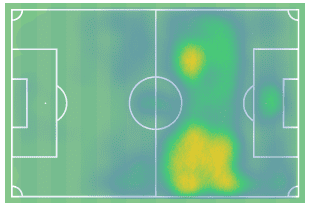
In 2018/19, he spent the season on loan at Deportivo La Coruña and played in a somewhat similar role. Rather than verging to the left, he primarily featured on the left and also spent some spells in a more advanced, central role. Here, the major difference which we can note beyond which flank he is on is the amount of time spent in central areas. This reflects how he was used as the sole central striker at times in Segunda, yet still dropped into a deeper role on a regular basis and was clearly more comfortable in such a position, rather than as a fox in the box poacher.
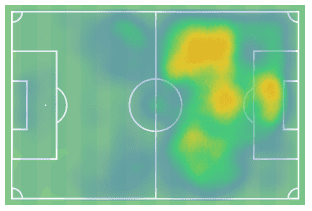
This is again reflected here below. It shows a typical move forward from Granada, with a long ball over the top. Fernández would start in a slightly deeper position than his strike partner Soldado, moving wide to the right and stretching the defence in the process. With a wide player or full-back coming up to support him, Fernández would lay the ball off and move inside into the space he has created, or just cut inside himself.
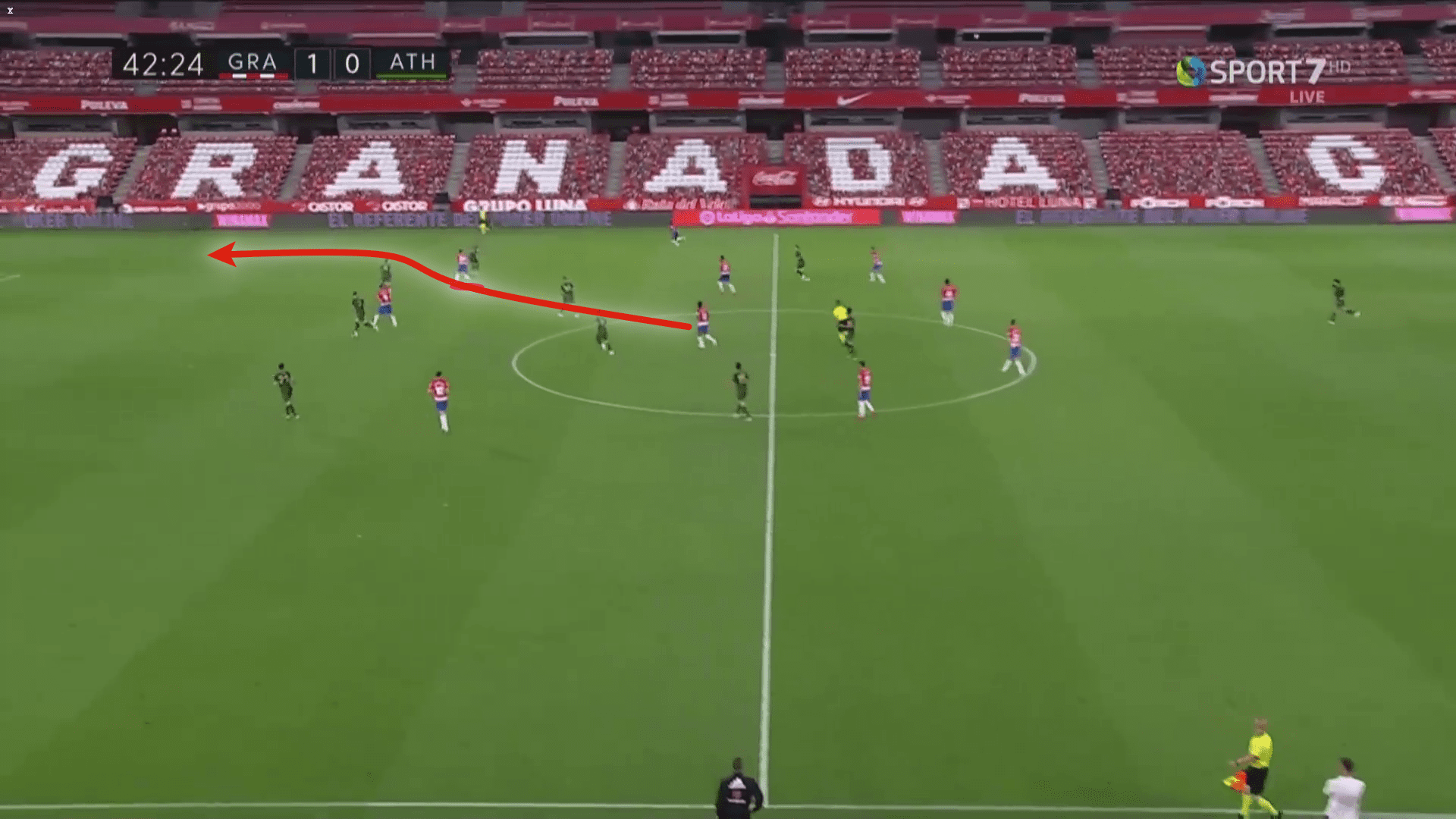
Such flexibility is a real asset within Fernández’s game. If he is to prove an asset for Sevilla, this is where he will come into play. Much like Munir El Haddadi, who can play in the same roles anywhere across the front line or slightly deeper, Lopetegui values such versatile options, particularly to come from the bench to change a game. Proven in LaLiga and a homegrown talent, it is hard to imagine that Fernández would not be considered on this factor alone.
Strengths
The role in which Fernández excels is built largely around his strengths. His excellent link-up play and intelligence on the ball is clear, showing the pedigree of a player to have come through one of Spain’s strongest youth academies. This is evident in how quickly he makes decisions, assessing moves and spaces before receiving the ball efficiently and allowing him to often play killer passes or place shots well with his first or second touch.
His technical ability also shines through, as will be considered here. Not only is Fernández aware enough in possession, though he does sometimes rush into decisions as will be considered later, but he also has the ability to turn possession into danger. Building upon his previous loan spell with Dépor, this is perhaps the biggest area of improvement that we have seen from Fernández while with Granada.
Link-up play in a front two
One of Fernández’s biggest strengths is how he holds up the ball and links up play. As we have seen, a long and direct pass into the final third will often be with the intention of Fernández exploiting space, running wide to create space. However, on some occasions, it does stay in a central area where Soldado will do much of the target man work, but Fernández also does his fair share and will tend to drop into a deeper role. Typically, Soldado would remain on the last man as Fernández drops to connect play.
That is reflected in the fact that he has received 2.06 long passes per game, the 36th highest figure for a LaLiga player in 2019/20. He is strong in the air, which is a major positive for Granada given that he is involved in 9.76 aerial duels per game, but this is reflected primarily in how he interprets play around him. Here, Marchís is already making the run in behind as Fernández drops in to win the header, pulling out the central defender to create greater space in the defensive line that he leaves behind. Flicking his header on by positioning himself well between the midfield and defence, his header was perfectly weighted for Marchís to make his run.
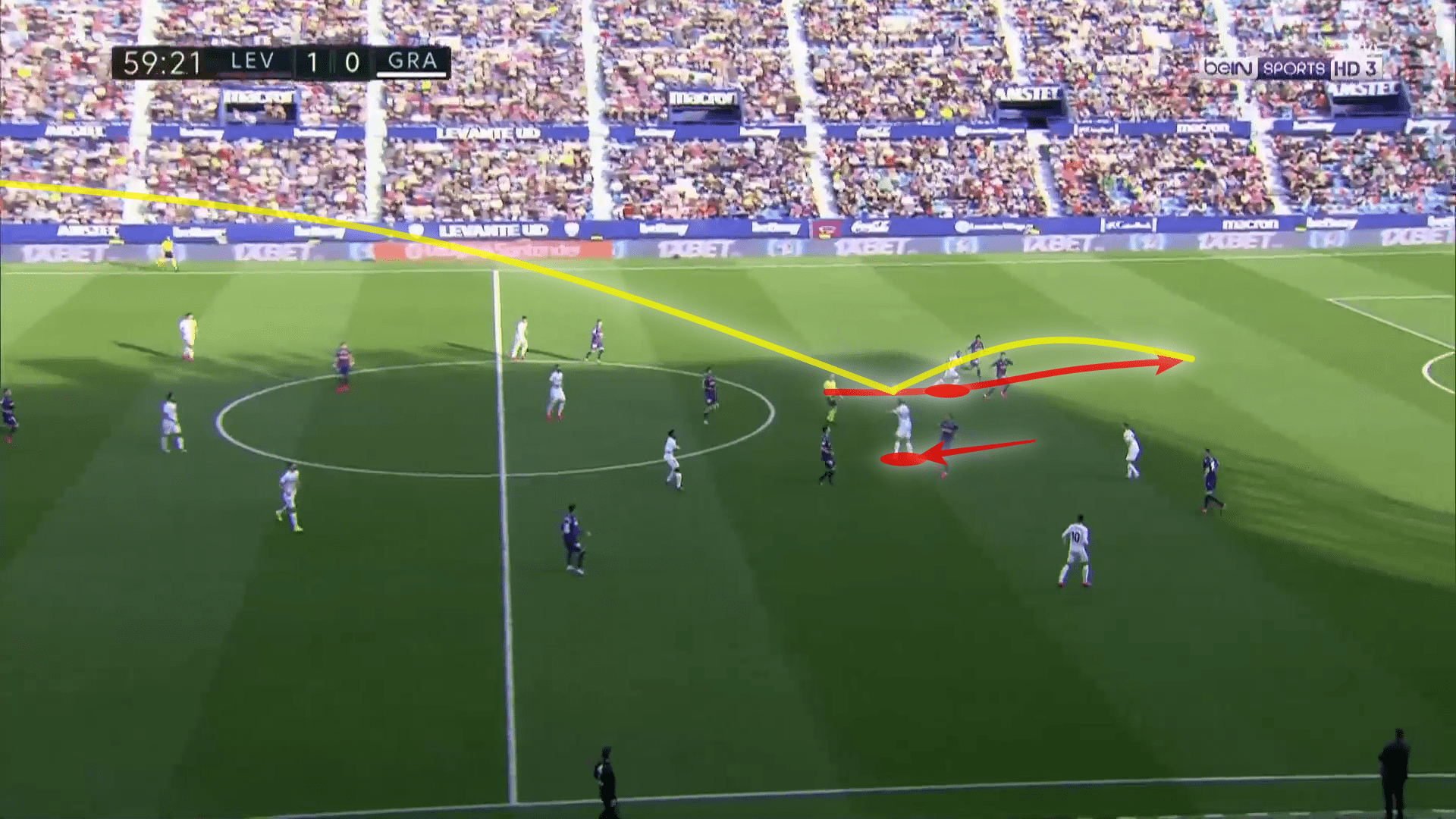
It is not just in the air where Fernández is strong. In fact, while his assist stats are not out of this world, Fernández is actually a threat with the ball at his feet when it comes to picking out a pass. Again, he deploys the same move of stepping into a deeper role and pulling a central defender with him to open up space in behind which others are more than happy to pick up upon.
In this example against Espanyol, we see a similar move to that shown against Levante, only this time the ball is coming to Fernández from a short pass from the midfield. Providing this link is an essential part of Fernández’s work which invites Soldado and Marchís to move in behind. Despite having more time to turn and take a touch, Fernández’s quick thinking and intelligence is shown, often looking to play the ball with a single touch or two if required, rather than slowing the pace of the game as Soldado is often guilty of when the ball is played into him.
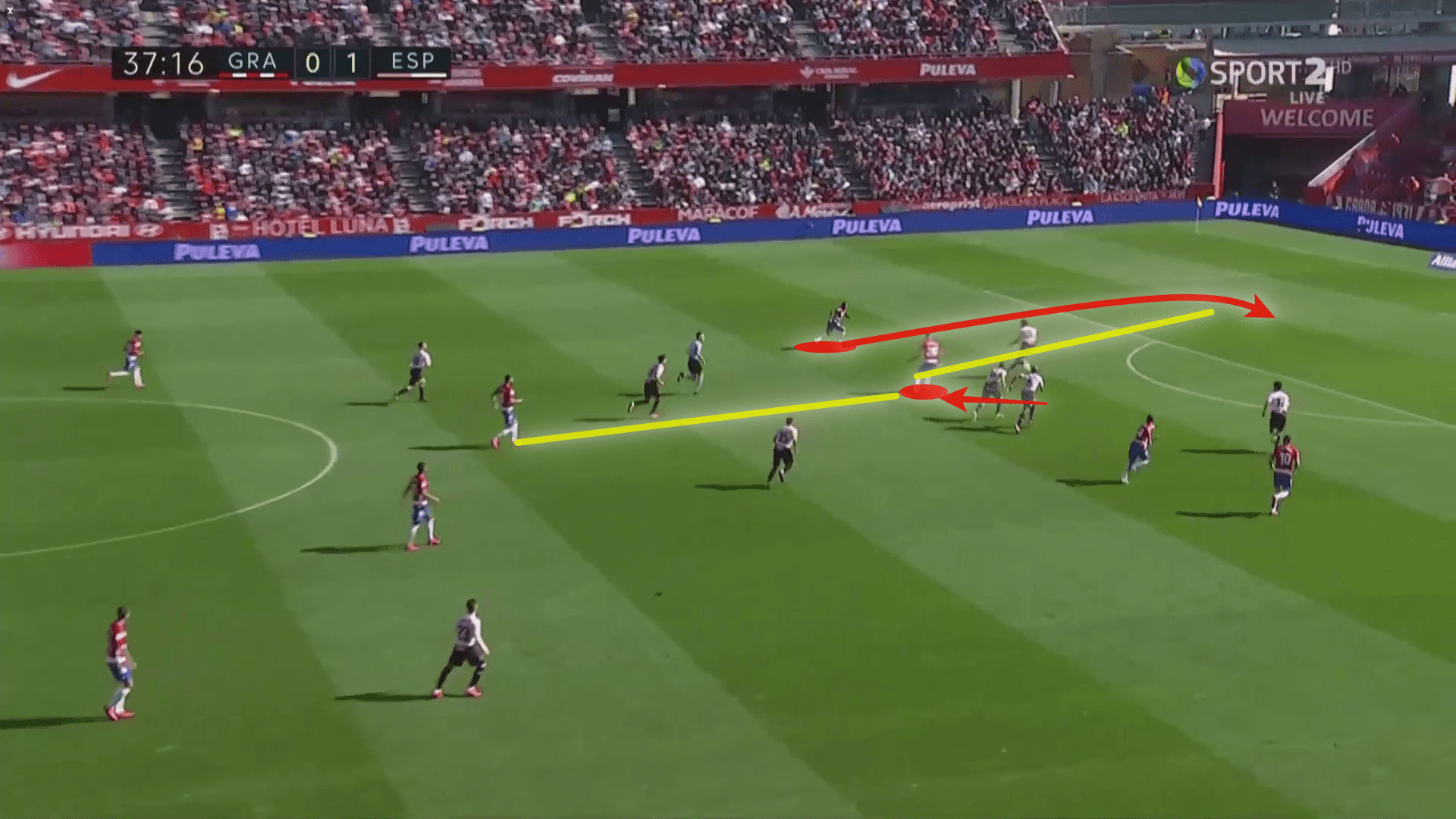
This has been an area of his game which he has improved upon significantly since joining Granada. At Deportivo La Coruña last season, he produced 1.21 fewer forward passes per 90 minutes, but when he was involved in build-up play it largely came as he put crosses in from wide. Instead at Granada, he plays more of a central role, providing knock-ons or passes into space from a deeper position having dropped to make himself available.
Clinical finisher
What will really stand out to Lopetegui will be the fact that Fernández is a clinical finisher on a level which no other Sevilla centre-forward can compete with. Boasting 10.29 xG compared to 13 goals, his xG surplus is better than that of any other striker in the Sevilla squad and is only beaten by that of player of the season Lucas Ocampos.
What is more impressive is that the majority of his goals came from chances worth less than 0.25 xG, showing the quality of his finishing. A goal conversion rate inside the box of 31.6% is impressive, showing how he takes his chances when receiving the ball in front of goal.
Here, his intelligence is again shown. 92.3% of Fernández’s goals came from inside the box and often with very little time or space to manoeuvre and that is the case here. As the cross comes in, Fernández identifies that it is not played into his path and he must instead slow down his run in order to connect. Even then, he spins to lose the defender and with the goalkeeper, Sergio Asenjo, naturally moving onto his left foot as Fernández moves to his left, but Fernández instead fires the ball into the bottom right corner with an unnatural body movement which catches the goalkeeper unaware.
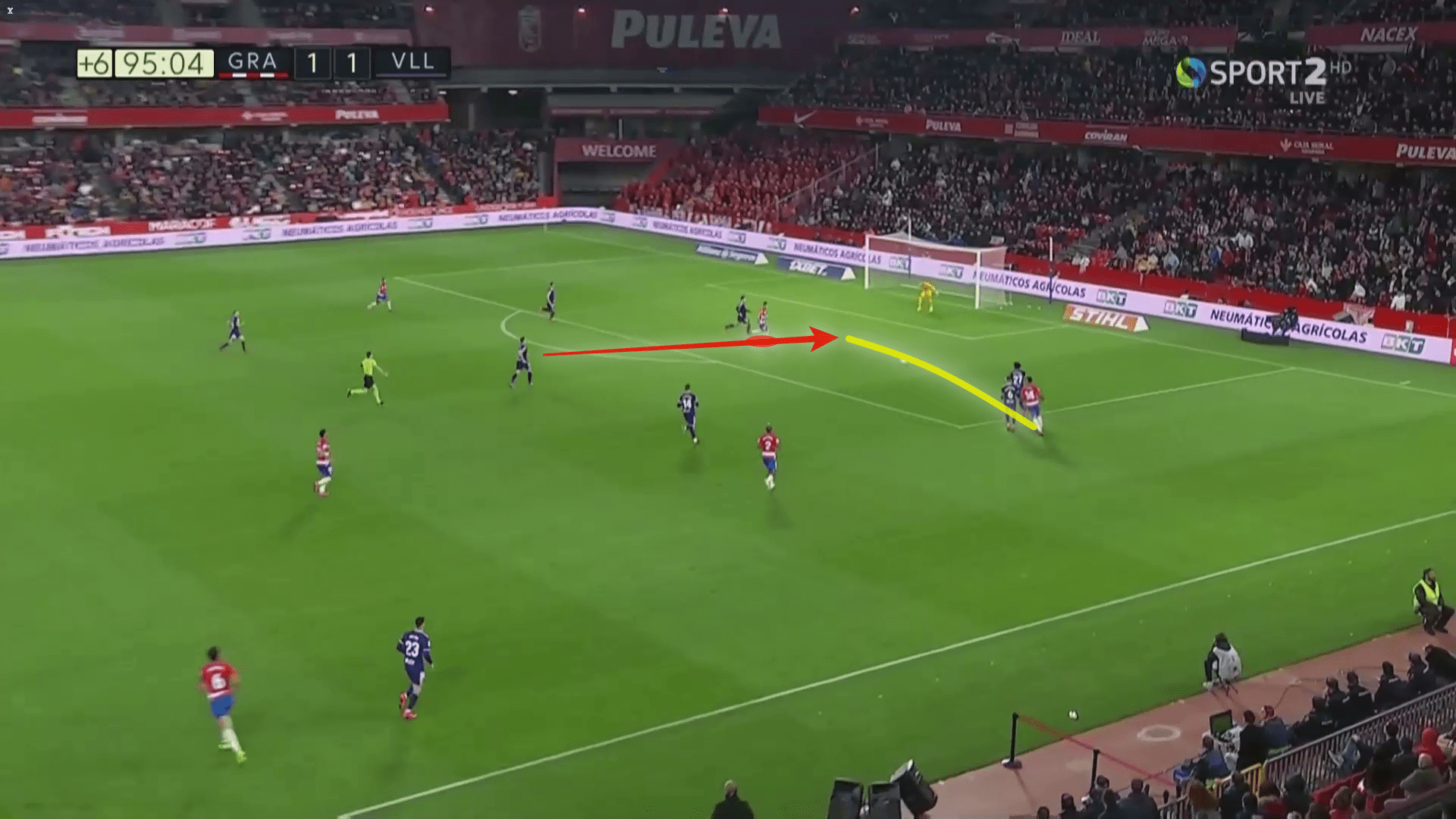
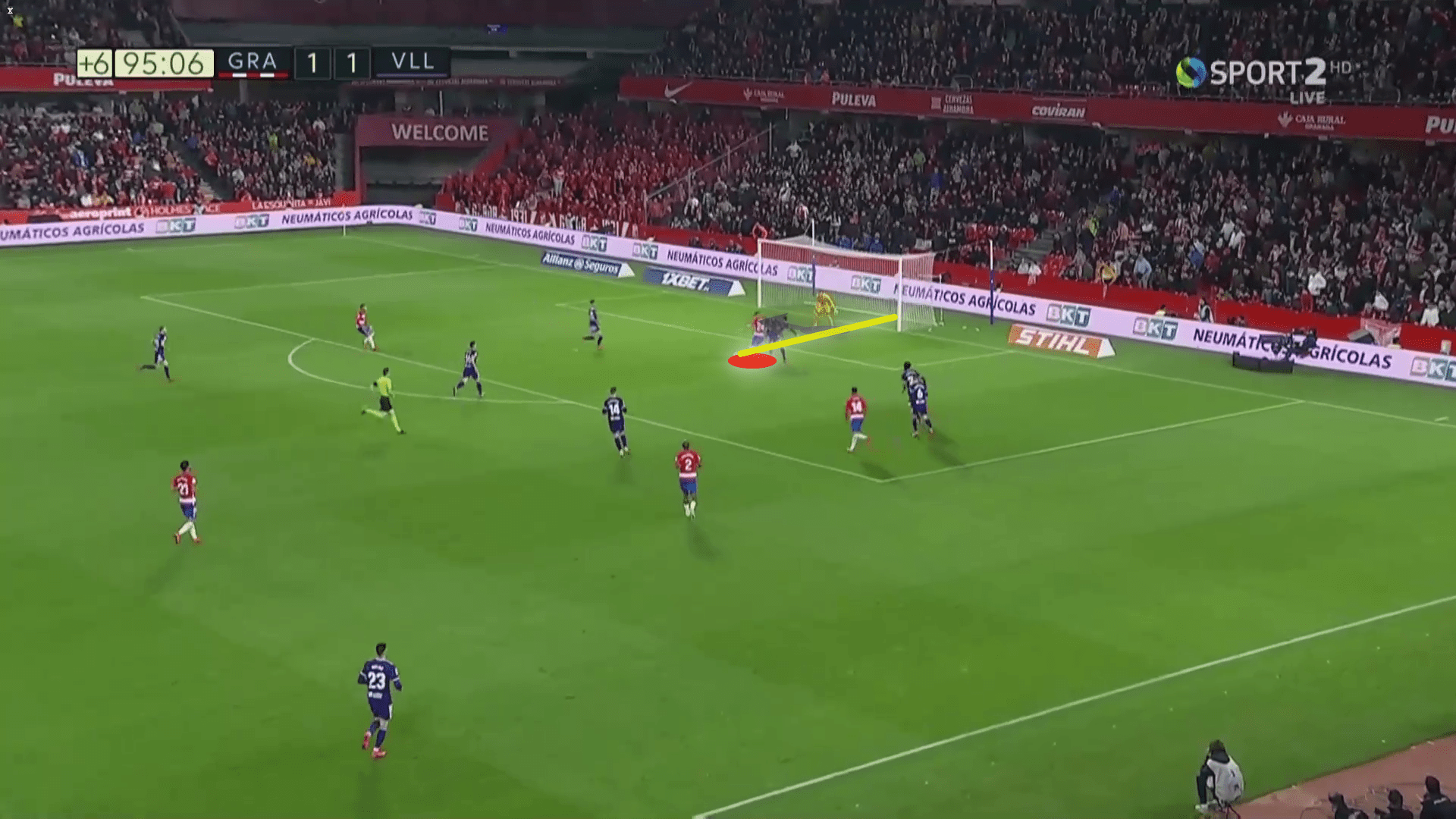
This is essential for Fernández as he begins to bring in these movements to his game. At times in the past, he was accused of being too predictable, particularly as 59.3% of his shots came from his left foot with just 14.8% on his right. This was a large part of why Martínez looks to push him towards the right, rather than the left as he played at Dépor, instead cutting inside onto his left to unleash a shot on goal on his stronger foot.
That does not mean that he can’t produce on his right foot though, as he reflected against Espanyol with a trademark move. Cutting in from the left and without great pressure from the defence, he continued to press on and curl an effort into the top corner. This is a regular move, though one which does not always come off for the striker.
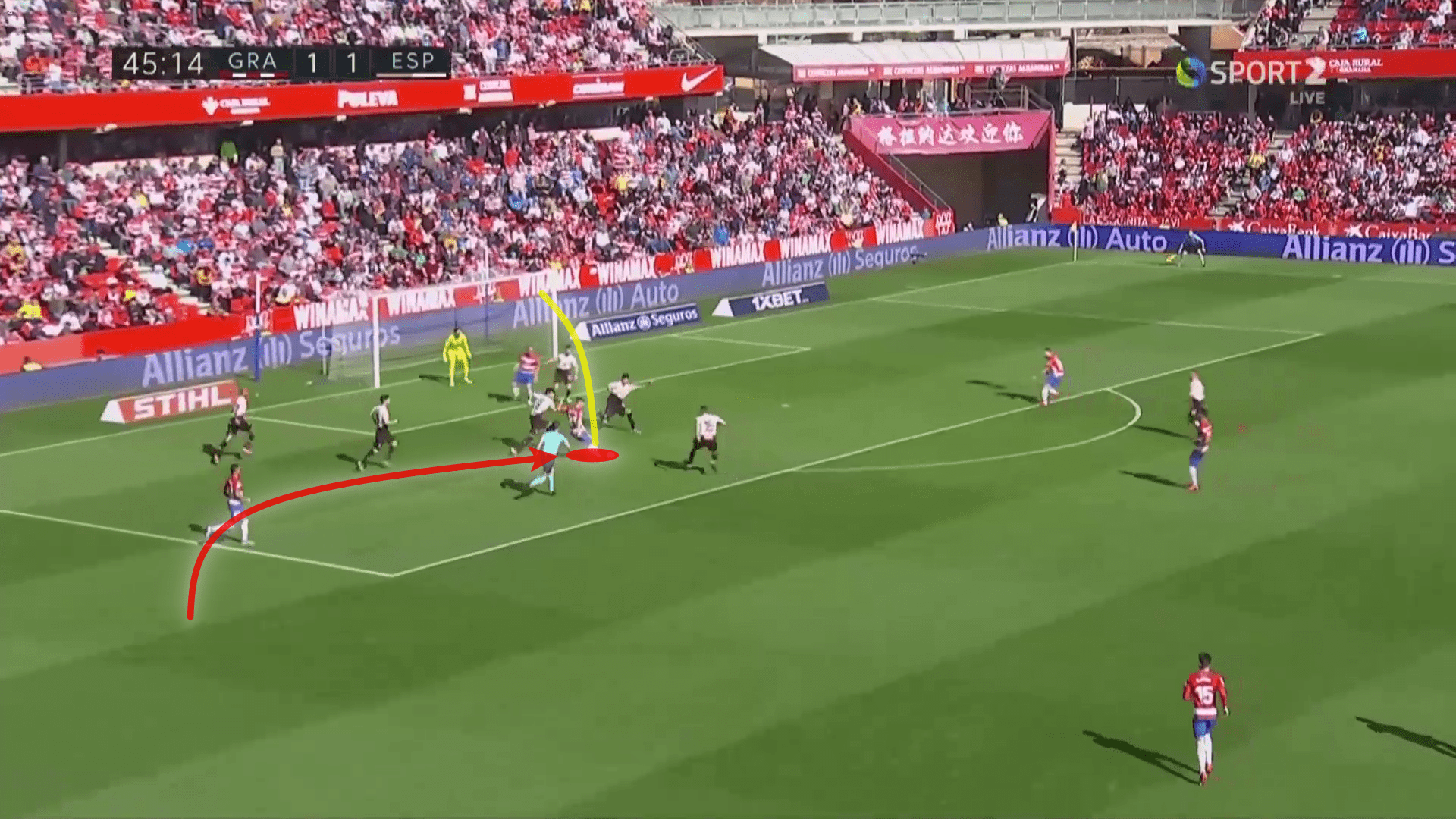
Fernández is also strong in the air. This is primarily down to his movement where he will look to create space for himself. In total, 13% of his shots come from crosses or set pieces, with 14.8% of his total shots coming through headers.
This example against Athletic Club reflects that. As the ball is cut back, Fernández identifies the space at the near post and immediately curves his run to attack it aggressively. As the ball comes in, Fernández then has the time and space to flick the header into the bottom corner, without any pressure on him, allowing him to gain greater traction to jump higher and with more body movement allowing him to get greater power on his header.
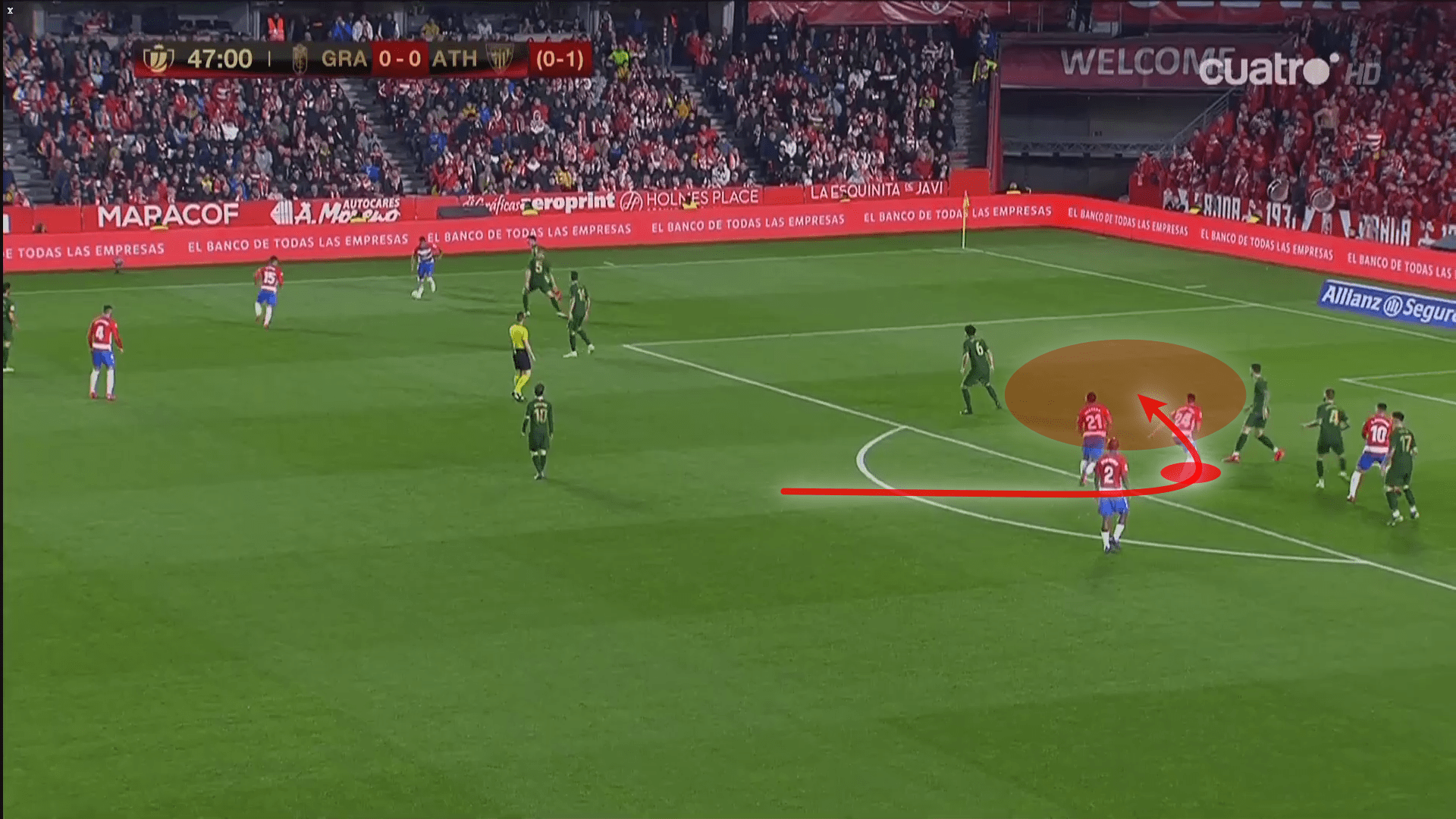
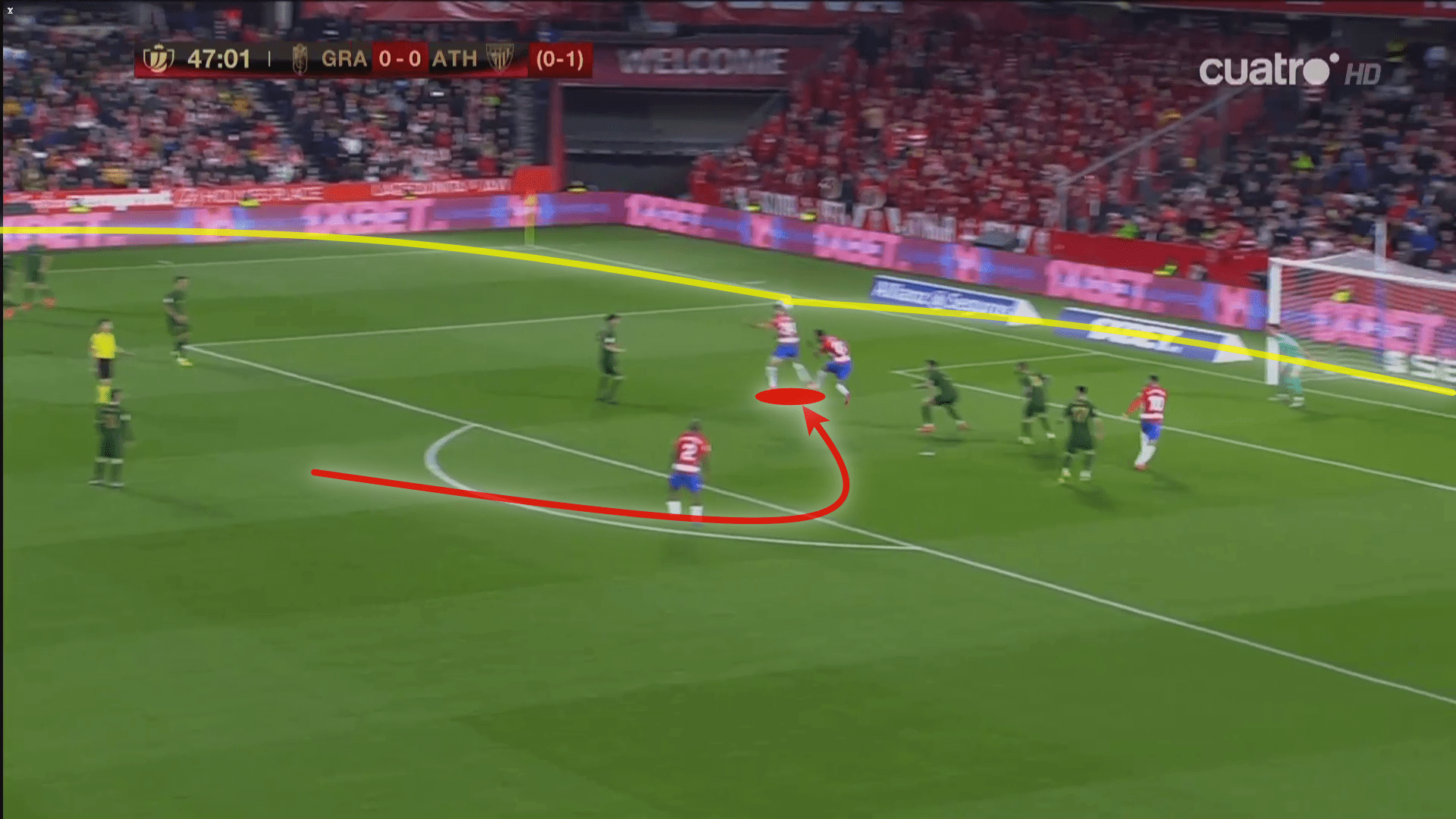
This last strength will be particularly appealing for Lopetegui. Much of Sevilla’s play comes down the flanks with crosses into the box and that would clearly suit Fernández well. The challenge for him will be to maintain the impressive conversion rate when he is playing against teams with a lower block who do not allow so much space for the forwards to move into.
Weaknesses
However, there is a reason that Sevilla have loaned Fernández out for the past two seasons and it is not entirely down to the fact that he has struggled to fit into the Sevilla system. Neither Lopetegui nor Pablo Machín felt that he was quite ready to be playing at the elite level that Sevilla compete at. His year at Granada has helped him to build upon his game and improve his weak areas, but in some areas he is still showing signs of his inexperience.
Generally, these weaknesses relate to poor decision making from Fernández, rushing into decisions and committing when he could instead be more patient, taking a breath and then reacting in a more positive way which would help his team.
Poor pressing
One of these areas is in how Fernández presses. Alongside 35-year-old Soldado, much of the defensive leg work is passed on to the loanee to do in attack, but it is not his biggest strength. In fact, it is one of his weakest areas and one where, unlike so much else in his game when in possession, he shows a lack of tactical awareness and poor decision making.
Here, against Real Madrid, we can see a good example. Fernández begins the move well positioned, inside his own half and deep with Marcelo on the ball and struggling to find any gaps in the Granada midfield to find a way through. However, Fernández breaks ranks needlessly to step up and close him down when he is posing no threat. His body positioning is poor, attempting to show him wide but instead giving him a clear run down the channel. Marcelo identifies the oncoming press and quickly dribbles past Fernández, leaving him for dead behind him despite having started in a superior position.
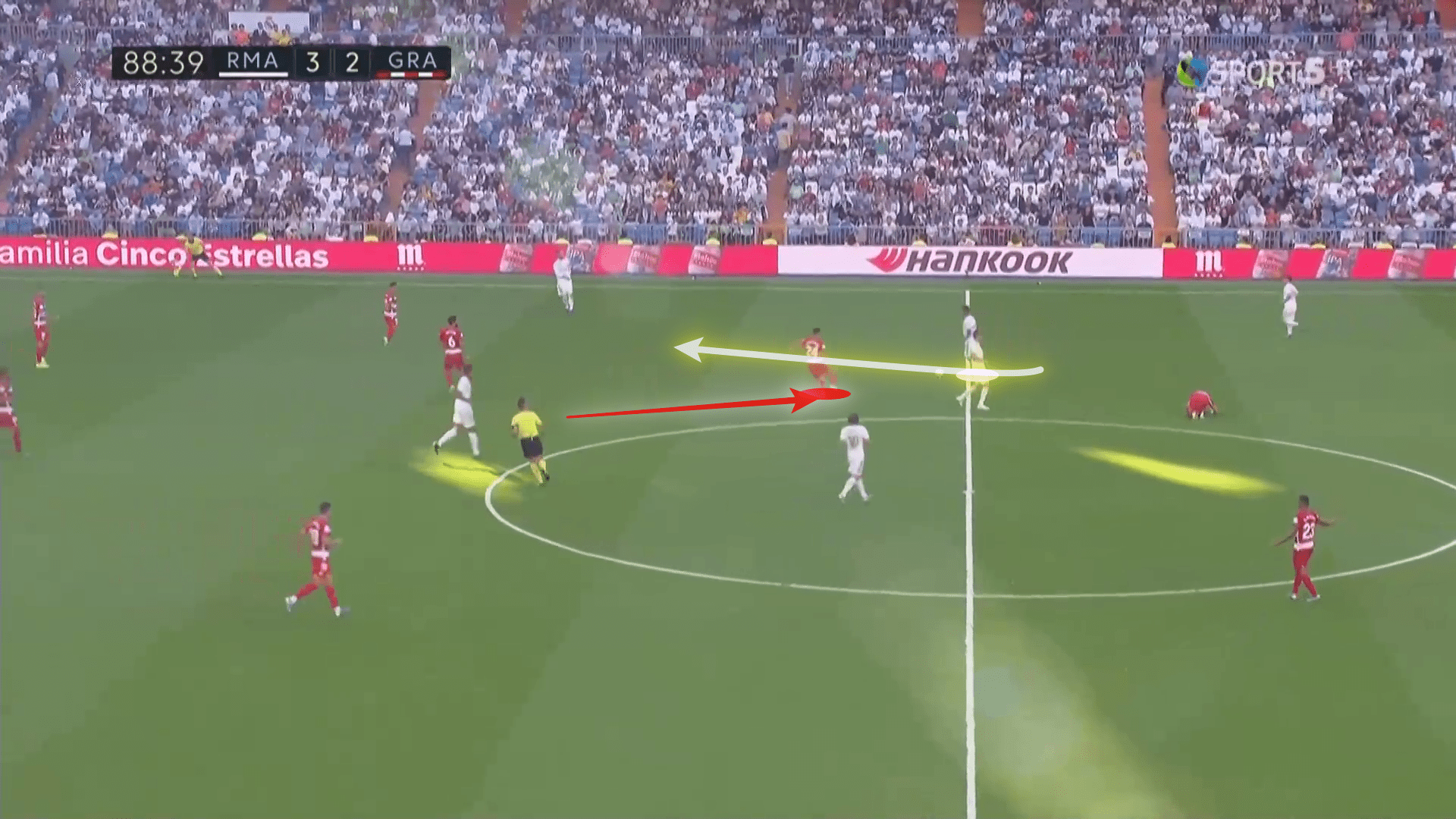
What this leads to is another negative as Fernández concedes an unusually high number of fouls for a forward at 2.36 fouls conceded per 90 minutes, the 24th highest figure in LaLiga and the 10th highest of any striker. Often, high fouling forwards attribute this characteristic to a lack of pace due to age leading to frustration fouls or tactical fouls from the front in physical sides like Eibar or Getafe, however Granada do not fall into this category and Fernández is the highest fouling forward under 25 in the division.
This is primarily due to situations such as this example against Levante. Fernández overcommits and can easily be skipped past as his challenge is predictable and late. Fernández throws in a leg anyway, preventing a counter-attack on this occasion, but equally conceding a free-kick which on other occasions may take place in a far more threatening position.
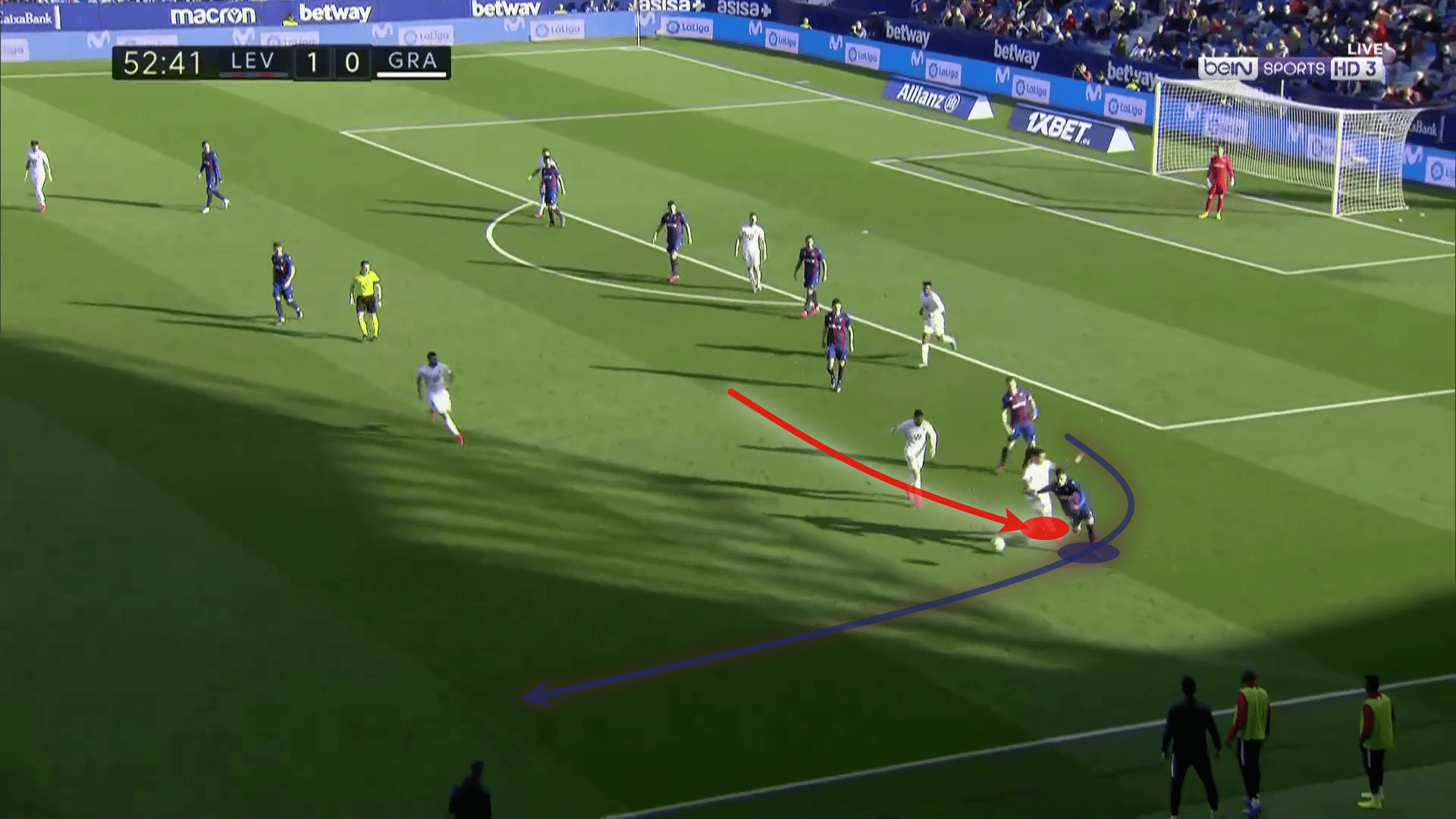
This ill discipline led to two yellow cards, while another two were given for needless behavioural issues such as clashing with an opposition player and kicking the ball away. This aspect of his game will be one that Lopetegui will be keen to stamp out, removing needless aggression from his game to form part of his more methodical approach.
Long passing vision
When on the ball, Fernández is not always spot on either. There are similarities though, as it often comes down to the fact that he rushes into decisions and takes risks when there are simple alternatives available for him which would benefit the team more. This weakness is one that Lopetegui will look to stamp out in his side, instead focusing on retaining possession if Fernández is to have a bright future at Sevilla.
Despite attempting 0.76 long passes per game, only 52% are completed. This is because he often looks for highly ambitious passes, such as this one against Badajoz, but is unable to execute it as well as he had hoped. In some circumstances this is understandable within the less possession-focused style of Granada, but that will not be the case at Sevilla.
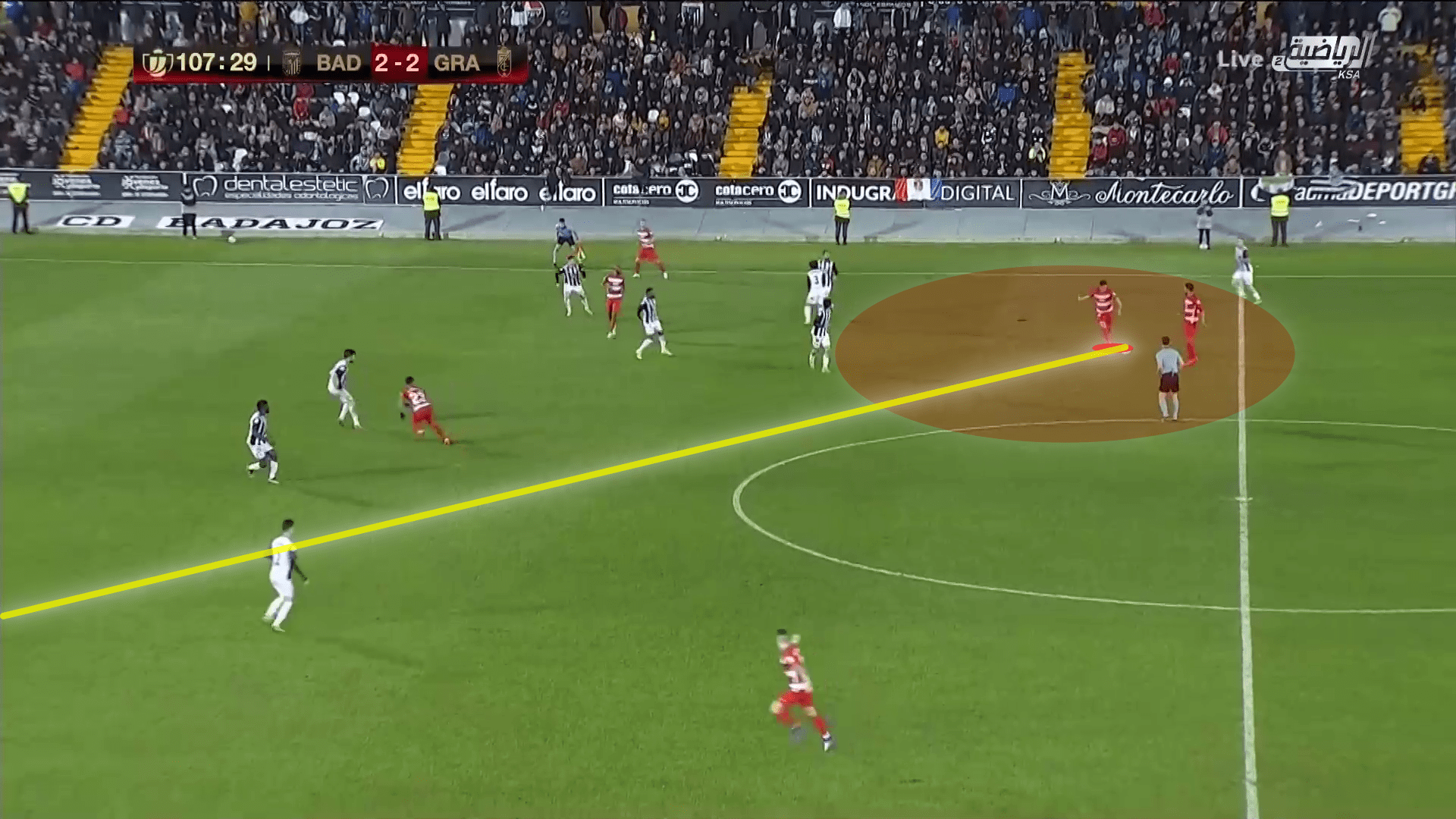
While this may be a concern, it is more worrying when we witness that Fernández takes this choice when he has numerous easy passing options available to him. This primarily occurs when in wide positions, which is where Fernández does opt for a longer pass more often. Rather than play a simple pass, he looks to play a longer pass.
In this below example from the meeting with Eibar, Fernández has as many as five open passing options but instead looks to switch play immediately, rushing into a passing decision. The end result is that his pass goes out of play to lose possession unnecessarily.
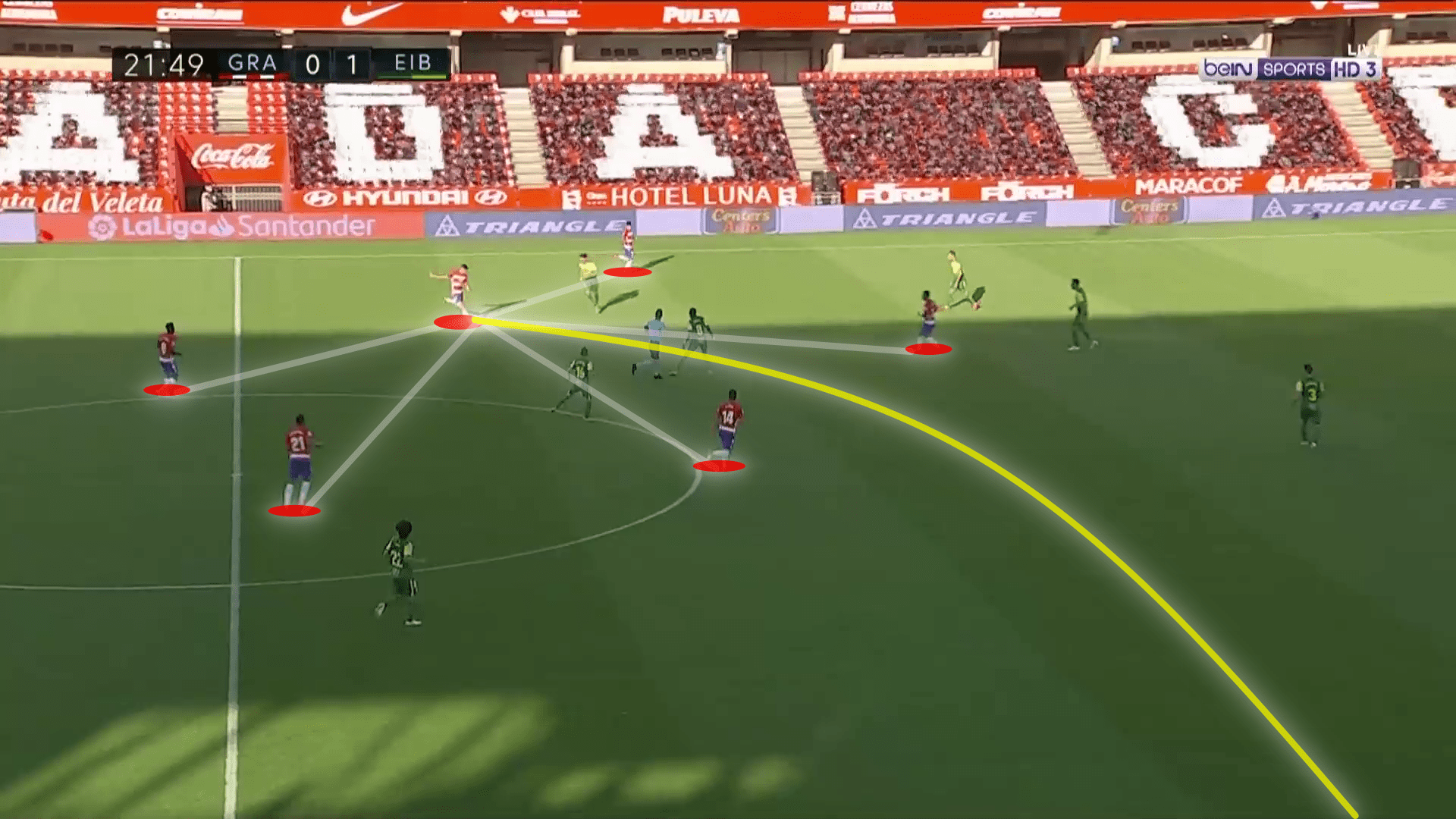
This needlessly easy loss of possession is not just problematic because his team has lost the ball, but also because of the nature of it, particularly in this case against Eibar. With full-backs running forward on the overlap, a loss in possession means that he is leaving the Granada defence heavily exposed.
Bizarrely, this may actually not be as problematic at Sevilla. Lopetegui looks to keep his team playing shorter and quicker passes, third only to Real Madrid and Barcelona at 15.5 passes per minute. This reflects how such long passes are not part of Sevilla’s tactics and this would be easier to avoid with more passing options presenting themselves quickly. Equally, the role of Jesús Navas and Sergio Reguilón pressing high on the flanks with defenders covering in behind means that they would not be left quite so exposed.
Conclusion
Fernández is clearly a bright and talented player. Intelligent and with technical quality in abundance, he is just what Sevilla have been looking for in attack. He can play the role of a target man, strong in the air and with good link-up play, but does not compromise on his talent with the ball at his feet, like En Nesyri, or in his finishing, like De Jong. As such, Fernández could be the perfect fit into Lopetegui’s system at Sevilla after an impressive campaign with Granada.
The challenge for the former Real Madrid and Spain coach will be to implement a little more discipline and help Fernández to turn the experience he has gained while out on loan into defining experiences to take another step up in quality. Learning how to press effectively and controlling his risk-taking in possession will be key to that.
Fernández has now put himself in the frame for a role at a top Spanish club and Sevilla could give him an ideal platform to improve further in 2020/21. With the Champions League coming up and the Euros in the summer, Fernández may well be a dark horse to make Spain’s squad if he can continue his fine form from his spell at Granada.

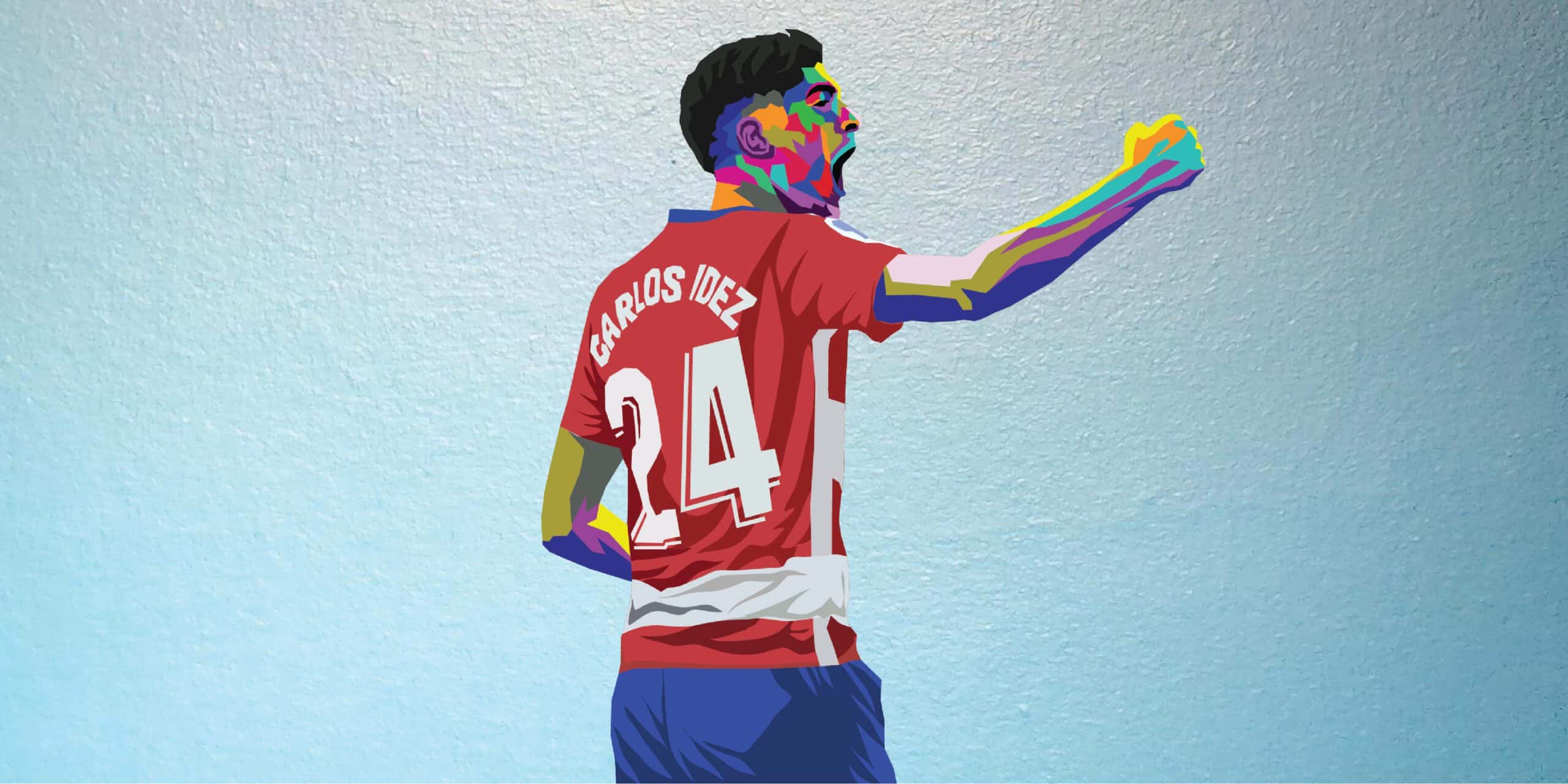



Comments